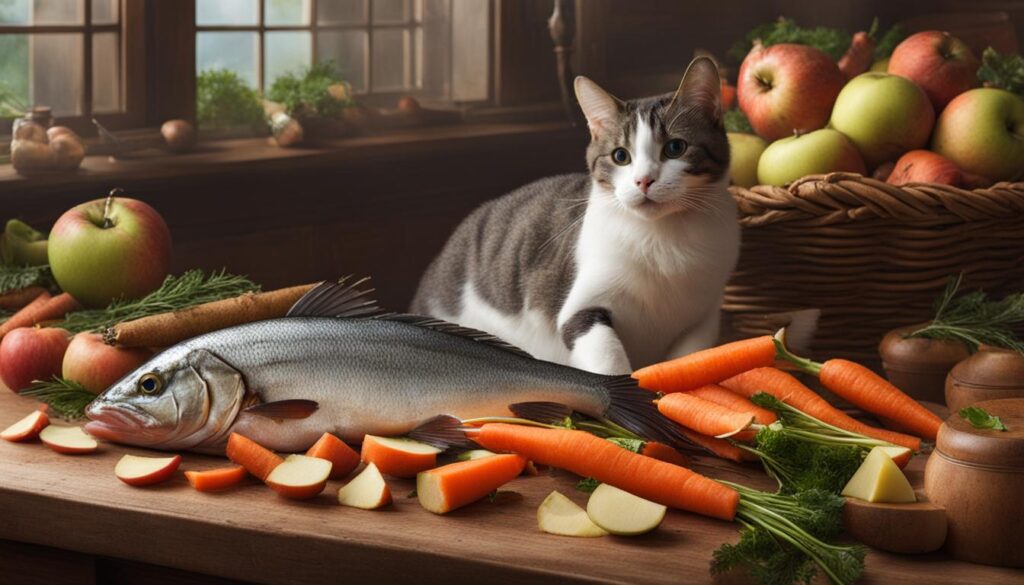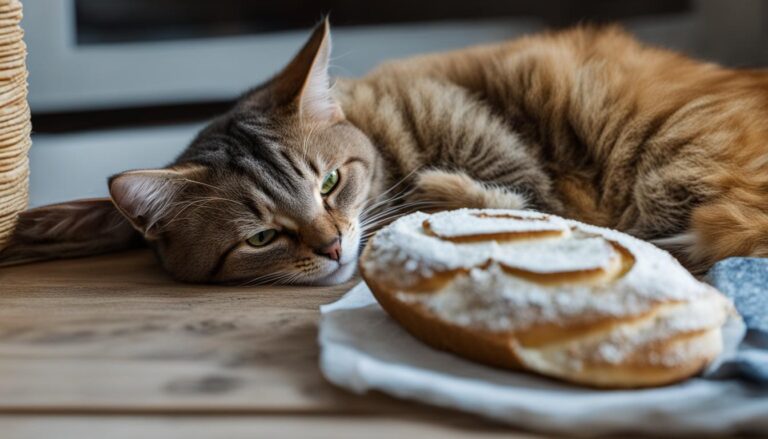Undrar du om det är säkert att mata din älskade kattvän med bröd? I den här guiden kommer vi att utforska ämnet katter och brödVi diskuterar potentiella risker, alternativ och vikten av en balanserad kost för katter. Låt oss dyka ner i kattdjurens näringsvärld och ta reda på om bröd är ett lämpligt alternativ för din katt.
Viktiga slutsatser
- Bröd ger inte katterna några näringsmässiga fördelar och kan leda till att de äter mindre av sin balanserade kattmat.
- Okokt bröddeg kan expandera i kattens mage och orsaka uppsvälldhet och obehag.
- Jästen i bröddegen kan producera ämnen som är skadliga för katter, t.ex. koldioxid och etanolalkohol.
- Katter är köttätare och behöver inte spannmål eller kolhydrater i sin kost.
- Att mata katter med vissa typer av bröd, t.ex. sådana som innehåller xylitol eller nötter, kan vara skadligt.
- Alternativen till bröd är kokt kött, skaldjur och speciellt framtagen våt- och torrfoder för katter.
- Att mata katter med alltför stora mängder bröd kan leda till hälsokomplikationer och symtom.
Innehållsförteckning
Varför är bröd skadligt för katter?
Att mata katter med bröd kan ha skadliga effekter på deras hälsa och allmänna näring. Katter är obligatoriska köttätare, vilket innebär att deras kost främst bör bestå av köttprotein. Bröd, å andra sidan, innehåller mycket kolhydrater och saknar de viktiga näringsämnen som katter behöver för optimal hälsa.
Bröd kan leda till viktökning, fetma och till och med diabetes hos katter på grund av dess höga kolhydratinnehåll. Katter metaboliserar kolhydrater på ett annat sätt än människor och hundar, och deras kroppar är inte utformade för att effektivt bearbeta stora mängder kolhydrater. Regelbunden konsumtion av bröd kan störa kattens naturliga kost och leda till olika hälsokomplikationer.
Dessutom kan vissa ingredienser i bröd, t.ex. korn och jäst, orsaka allergiska reaktioner hos katter. Dessa allergiska reaktioner kan yttra sig som kräkningar, diarré och andra gastrointestinala problem. Rå bröddeg är särskilt farligt eftersom det kan expandera i kattens mage, vilket leder till uppblåsthet och obehag. Jästens jäsningsprocess i kattens mage kan också producera etanol och koldioxid, som är giftiga för katter och kan leda till organsvikt.
Riskerna med att mata katter med bröd
Att mata katter med bröd innebär flera risker, bland annat:
- Otillräcklig näringstillförsel: Katter behöver en proteinrik kost och bröd tillgodoser inte deras näringsbehov.
- Viktökning och fetma: Det höga kolhydratinnehållet i bröd kan bidra till viktuppgång och fetma hos katter.
- Allergiska reaktioner: Katter kan vara allergiska mot ingredienser som finns i bröd, t.ex. korn och jäst, vilket kan leda till mag- och tarmproblem.
- Risker med rå deg: Rå bröddeg kan expandera i kattens mage och orsaka uppsvälldhet och obehag.
- Toxicitet från jäsning: Jästens jäsningsprocess i kattens mage kan ge upphov till giftiga ämnen som kan leda till organsvikt.
| Risker med att mata katter med bröd | Effekter på katter |
|---|---|
| Otillräcklig näringstillförsel | Bröd saknar de näringsämnen som behövs för kattens hälsa och välbefinnande. |
| Viktuppgång och fetma | Den höga kolhydrathalten i bröd kan bidra till viktuppgång och fetma hos katter. |
| Allergiska reaktioner | Ingredienser som finns i bröd, t.ex. korn och jäst, kan orsaka allergiska reaktioner hos katter. |
| Risker med rå deg | Rå bröddeg kan expandera i kattens mage och orsaka uppsvälldhet och obehag. |
| Toxicitet från fermentering | Jästens jäsningsprocess i kattens mage kan ge upphov till giftiga ämnen som kan leda till organsvikt. |
Med tanke på de potentiella riskerna och bristen på näringsvärde är det bäst att undvika att mata katter med bröd. Fokusera istället på att ge dem en balanserad, proteinrik kost som uppfyller deras näringsbehov. Rådgivning med en veterinär kan också bidra till att säkerställa att kattens näringsbehov tillgodoses på ett adekvat sätt.
Alternativ till bröd för katter
Om du letar efter kattvänliga livsmedel och hälsosamma godbitar till din kattkompis finns det gott om alternativ till bröd som kan tillgodose deras näringsbehov. Katter är köttätare, så det är viktigt att fokusera på att ge dem en proteinrik kost. Här är några alternativ:
- Tillagat kött eller skaldjur: Små mängder kokt kyckling, tonfisk, nötkött, lamm, räkor, räkor, lax och makrill kan vara en utsökt och näringsrik godbit för katter. Se bara till att ta bort eventuella ben, kryddor och överflödigt fett.
- Ägg och äggula: Kokta ägg, både vitor och gulor, kan vara en bra proteinkälla för katter. Se till att de är helt genomkokta för att undvika risken för salmonella.
- Våt och torr kattmat: Leta efter högkvalitativ kattmat som är särskilt framtagen för katters hälsa. Genom att kombinera våt- och torrfoder kan du ge din katt en balanserad kost.
Det är viktigt att notera att vissa livsmedel från människor kan vara skadliga för katterså det är bäst att undvika dem helt och hållet. Livsmedel som alkohol, citrusfrukter, kaffe, kokosnöt, vindruvor och russin, mejeriprodukter, svamp, lök, vitlök, purjolök, gräslök, salladslök och schalottenlök bör aldrig ges till katter eftersom de kan vara giftiga för deras hälsa.
Genom att ge din katt en mängd olika proteinrika livsmedel och undvika skadliga ingredienser kan du säkerställa dess hälsa och välbefinnande. Rådgör alltid med din veterinär för att fastställa den bästa dieten för din katt och ta hänsyn till eventuella särskilda kostbehov eller restriktioner som katten kan ha.
Kom ihåg att en balanserad och näringsrik kost är nyckeln till att hålla din katt glad och frisk!

Potentiella risker och symtom på brödtoxicitet hos katter
Att mata katter med bröd kan innebära flera hälsorisker och leda till olika komplikationer. Katter är köttätare och deras matsmältningssystem är inte utformat för att bearbeta spannmål och kolhydrater på ett effektivt sätt. När katter äter bröd kan det leda till gastrointestinala störningar och matsmältningsproblem. Några vanliga symptom på brödförgiftning hos katter inkludera:
- Diarré: Katter kan få lös avföring eller täta tarmtömningar efter att ha ätit bröd.
- Kräkningar: Förtäring av bröd kan få katter att kräkas, vilket kan leda till uttorkning om det inte åtgärdas omedelbart.
- Hosta: Brödpartiklar kan irritera kattens hals och leda till hosta eller kväljningar.
- Lethargy: Katter kan bli slöa eller visa brist på energi efter att ha ätit bröd.
- Viktminskning: Bröd innehåller mycket kalorier och har lågt näringsvärde, vilket kan bidra till ohälsosam viktminskning hos katter.
- Aptitlöshet: Katter kan tappa intresset för sin vanliga mat efter att ha ätit bröd, vilket stör den totala kostbalansen.
- Uttorkning: Bröd kan absorbera fukt i matsmältningssystemet, vilket leder till uttorkning om inte ett tillräckligt vattenintag upprätthålls.
- Krampanfall: I extrema fall kan brödförgiftning leda till krampanfall och andra neurologiska symtom.
- Håravfall och klåda: Allergiska reaktioner mot bröd kan visa sig som hudproblem, inklusive håravfall och klåda.
- Öroninfektioner: Den jäst som finns i bröd kan bidra till öroninfektioner hos katter.
- Hudutslag och spruckna trampdynor: Vissa katter kan få hudutslag och irritation, och spruckna trampdynor är ett möjligt symptom på brödförgiftning.
Det är viktigt att notera att dessa symtom kan variera beroende på den enskilda kattens känslighet och mängden bröd som intagits. Om du observerar något av dessa symtom hos din katt efter att den har ätit bröd, rekommenderas att du söker veterinärvård för korrekt diagnos och behandling.
Kom ihåg att bröd inte bör vara en vanlig del av kattens kost, eftersom det inte ger de näringsämnen som behövs för kattens välbefinnande. Fokusera istället på att ge en balanserad kattspecifik kost som innehåller högkvalitativa proteinkällor och kattvänliga livsmedel för att stödja deras allmänna hälsa.
Slutsats
Även om katter kan äta bröd i små mängder utan omedelbar skadaDet är inte rekommenderat att inkludera bröd i deras vanliga kost. Bröd saknar det nödvändiga näringsvärdet för katter och kan leda till hälsokomplikationer vid överdriven konsumtion. Katter är obligatoriska köttätare och mår bra av en proteinrik kost.
Det är bäst att ge katter en balanserad kattspecifik kost som innehåller kött eller skaldjur, tillsammans med våt och torr kattmat. Genom att fokusera på deras näringsbehov och undvika skadliga ingredienser, kan du säkerställa hälsa och välbefinnande för din kattkamrat.




